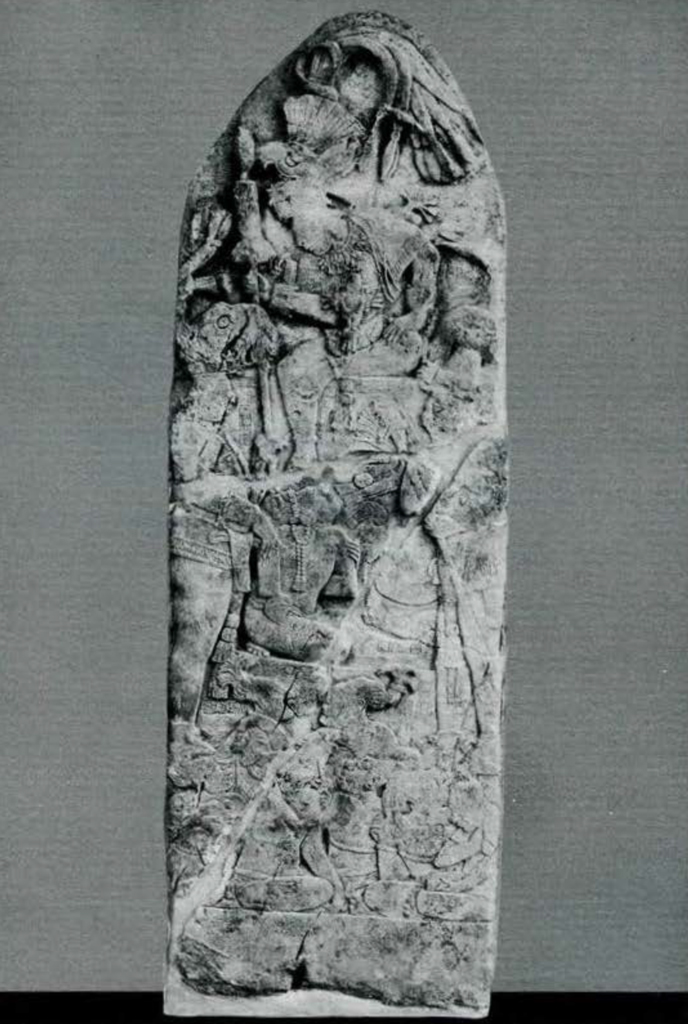THE stelae from the Early ‘Empire’ Maya city of Piedras Negras in Guatemala, secured by the Eldridge R. Johnson Expedition, which are now erected in the Museum, are not only among the very few large Maya monuments outside of Central America, but are some of the most artistic, if not the very finest, of all known Maya monuments. Preeminent among these is Stela 12 [Plate I]. This was the first one exported and the first to be received.

Image Number: 19318
Stela 12 originally stood high up on pyramid 0-13, on and around which were the most artistic sculptures at Piedras Negras, including stelae 12, 13, 14 and lintel 3, all now in the University Museum, and stela 15, now in Guatemala. It had broken in early days in four pieces, the lower two of which remained at the top of the pyramid, the upper ones having tumbled to the base. Their exportation was no easy task. The four pieces were individually boxed in planks of mahogany logs, sawn on the spot, loaded on wagons, drawn by oxen over the road made for the purpose, about thirty-five miles to the river below impassable rapids. They arrived there in May 1931, and remained there throughout the next rainy season. In January 1932 they were placed on a raft of mahogany and cedar logs, run through a small rapid and transported on the raft to the seaport of Alvaro Obregon from which they were brought by steamships to New Orleans and to Philadelphia.
As restored, the stela stands ten feet, four inches high, is forty-one inches wide and eighteen inches thick and must weigh about four tons. It is of yellowish limestone and is quite well preserved. Each side is, in accord with Maya custom, inscribed with two columns of hieroglyphs which give, in addition to other information, at present undecipherable, the date of erection. This is, in Maya chronology, 9.18.5.0.0. The correlation with our calendar is not yet determined to the satisfaction of all students but is probably September 15, of either A. D. 535 or 795.
The scene shown on the face, with remarkable artistic freedom, naturalistic quality, and feeling for composition and perspective, apparently represents the submission of a vanquished group. Above, in the center, is a seated figure, probably the ruler of Piedras Negras. His hand rests on his knee and the thigh is shown foreshortened. Flanking him to either side is a standing warrior. Below, in suppliant pose, is a figure which probably represents the chief of the conquered people. He is unbound and wears his necklace and ornaments, indicating that he is being received with the honors of war. At the base, bound with rope, their necklaces and other ornaments removed and their ear-ornaments torn out in degradation, are eight smaller figures, possibly captives destined for sacrifice. The grouping and freedom of pose of these are artistically praiseworthy. Accompanying each figure is a short line of small incised hieroglyphs which probably gives the name of the captive, or the native town or tribe that he represents. In the present state of our knowledge these glyphs are undecipherable.
The sculpture is the more remarkable when it is remembered that the Maya possessed no metal tools and the carving was made by the use of flint, obsidian, jade and other hard stones, and abrasives such as sand. Apparently these stelae were erected to mark the passage of time since their dates record intervals of exactly five years.
J. A. M.

